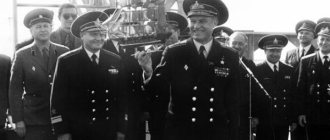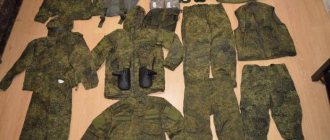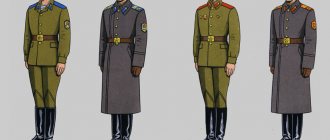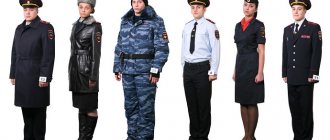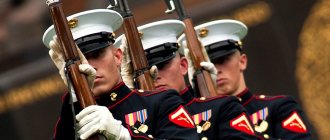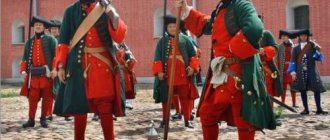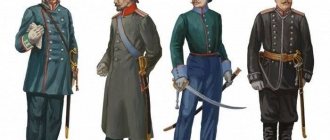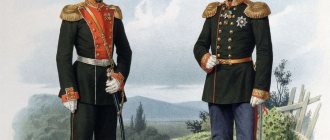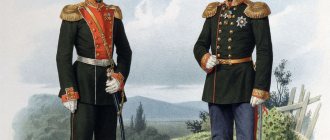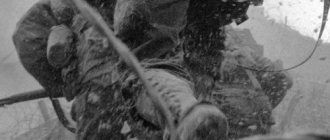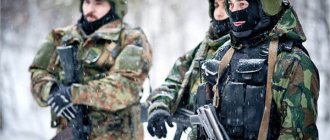History of naval dress
the Navy uniform dates back to the time of Peter the Great. By order of the powerful emperor-manager, in 1696 the Boyar Duma decided to create the first navy in the Russian state. October 30 is traditionally considered the Founding Day of the first Russian Fleet.
With its creation, Peter I introduced for sailors and representatives of the lower ranks a uniform created from items of naval clothing of Dutch naval employees, namely a gray or green jacket made of coarse wool, short green pants, stockings and a wide-brimmed hat. shoes served as footwear for naval employees . The uniform was also replaced by a work suit for every day. It included a loose shirt, canvas trousers, a cocked hat and a camisole. The sailors wore it during Ushakov’s Mediterranean campaign.
A work uniform, which included a set of gray canvas trousers and a shirt, was worn during any ship work, over which a uniform snow-white shirt with an azure collar was worn. This suit was approved as a uniform for privates in the summer of 1874.
Story
The first legendary fleet, numbering over 1000 ships, was assembled in the Boeotian harbor of Aulis by the Achaeans under the leadership of Agamemnon during the Trojan War. In the 5th century BC. e. The ancient Roman fleet began to form. At the beginning of the Middle Ages, the Byzantine fleet appears, and at the end it is replaced by the Ottoman fleet.
In 1588, the Invincible Armada was created in Spain, which was supposed to provide a naval landing to England, but the Spanish fleet (130 ships) was defeated by the British fleet (227 ships) in the Battle of Gravelines. From this moment on, the Thallasocracy of Great Britain begins. Various countries tried to challenge her power over the seas. A squadron of the French fleet (40 ships) was defeated by Vice Admiral Nelson's British squadron (33 ships) at the Battle of Trafalgar in 1805. And in 1827, the combined British-Russian-French squadron under the command of Vice Admiral Codrington (27 ships) defeated the Ottoman fleet (88 ships) in the Battle of Navarino.
During the First World War, Germany tried to challenge hegemony for world domination and in 1916 the grandiose Battle of Jutland took place with an uncertain outcome, where the German fleet of Admiral Scheer (99 ships) fought with the British fleet of Admiral Jellicoe (151 ships).
After World War II, the fleets received further development. They received new powerful means of combat. The organizational structure was improved, firepower, striking force, mobility, and the ability to perform tasks in the face of the enemy’s use of both conventional weapons and weapons of mass destruction increased.
Russia
Guys of the Russian Empire Navy
Stern flag of the Russian Empire Navy
USSR Navy flag
The Russian Navy is a branch of the armed forces that has an enormous history of creation and development, organizationally consisting of military command bodies (order, admiralty, general staff, ministry) and types of forces: surface, submarine, naval aviation, coastal artillery (coastal missile and artillery troops) and marines. It also includes auxiliary fleet vessels, special forces units (special forces) and various support services. In addition, the Navy has logistics (supply) units and institutions. Designed to protect the country from the enemy from sea directions.
At various periods in the history of Russia, its fleet bore the names:
- Russian Imperial Navy;
- Workers' and Peasants' Red Fleet (RKKF);
- USSR Navy (USSR Navy);
- Navy of the Russian Federation (Russian Navy).
Navy Day was celebrated in the USSR on the last Sunday of July. In the Armed Forces of the Russian Federation, the memorable Navy Day is celebrated on the same date.
Historical:
Army fleet (rowing)
During the imperial period, the following fleets existed in Russia:
- Azov Fleet;
- Baltic Fleet of the Russian Empire;
- Black Sea Fleet of the Russian Empire;
- Pacific Fleet of the Russian Empire.
During the Soviet period:
- Baltic Fleet of the USSR Navy;
- Northern Fleet of the USSR Navy;
- Pacific Fleet of the USSR Navy;
- Black Sea Fleet of the USSR Navy (see also Black Sea Fleet during the Great Patriotic War);
- Caspian Flotilla of the USSR Navy.
In the modern period there are:
- Baltic Fleet of the Russian Navy;
- Northern Fleet of the Russian Navy;
- Pacific Fleet of the Russian Navy;
- Black Sea Fleet of the Russian Navy;
- Caspian Flotilla of the Russian Navy.
USA
US Navy Flag
Main article: United States Navy
The US Navy includes such administrative and strategic units as the US Pacific Fleet, which forms operational fleets with odd numbers, and the US Fleet Forces Command (formerly the US Atlantic Fleet), which forms operational fleets with even numbers.
List of active American operational fleets:
- US Navy Third Fleet;
- US Navy Fourth Fleet;
- US Navy Fifth Fleet;
- US Navy Sixth Fleet;
- US Navy Seventh Fleet.
Historical:
- US Navy First Fleet;
- US Navy Second Fleet;
- Great White Fleet;
- US Navy Eighth Fleet;
- US Navy Tenth Fleet;
- US Navy Twelfth Fleet;
- US Asian Fleet.
About fabrics
Until the 80s, military everyday work uniforms for military personnel Navy were made of lightweight canvas, which was easy to clean from the most difficult stains. The Black Sea Fleet was dressed in white work clothes, the rest were most often blue. A little later, the color of the uniform changed to blue/dark blue, and the material became predominantly cotton fabric . The new uniform is sewn in a variety of studios, using all sorts of and not always high-quality materials. The new (currently approved) uniform can be of any color ranging from shades of black and blue. A good suit from a petty officer - thick, dark material.
Sailor casual uniform
What is the most common new naval suit for the current year 2015? Navy suit , or in the jargon of Navy personnel , a work dress (also a sailor's robe) is a form of work clothing for sailors, cadets of naval schools, as well as petty officers Navy . Since 2014, the dress has been called a tunic. The costume consists of the following items of clothing:
- Shirt.
- Trousers .
- Sailor collar.
- Shoes .
- Headdress.
Shirt
The shirt, worn, as a rule, with a special button-down collar, is cut on the model of an old sailor's shirt. Its back and front are one-piece without seams, with a wide turn-down collar. There is a patch pocket in front, and an internal pocket on the reverse side. There is a slit that fastens with a button. The shirt sleeves are straight, set-in; simple shoulder straps corresponding to the rank of the wearer of the uniform. A mandatory element of sailor clothing is a white tag with an indelible combat number. Such a shirt is worn untucked, and during service on watch it must be tucked into the pants. In cold weather, an overcoat, peacoat or coat .
Trousers
work trousers retained the tailoring and style of the 17th century. Sewn from dark blue cotton fabric. They have side pockets, fasteners located on the codpiece, as well as a belt with special loops (belt loops) for a belt . The belt is made mainly from pigskin, and on its plaque is the emblem Navy . The buckle of the model that existed in the USSR depicted an anchor with a star.
Collar
The collar is also made of cotton material, worn over the shirt, has a lining and three white stripes, symbolizing the victories of the Navy in such battles as Chesme, Gangut and Sinop. Dress naval clothing also includes a sailor collar.
Headdress
Navy uniforms . One of them is a trump cap , to which is attached a ribbon with the name of the ship or with the inscription “Navy”. The tape is put on the band. It, like the bottom and walls, is made of wool. On the crown of the headdress there is a cockade , which is a golden anchor. In the USSR, the cockade was a so-called crab - a red star framed by golden leaves. The summer cap is made of white fabric (comes with a replaceable cover). The winter headdress is a black fur hat with earflaps .
In 2014, plans were made to introduce a wool hat to replace the earflap hat for outdoor work. Also in 2014, other developments of a new form were carried out, but some innovations did not take root.
The casual uniform set also includes a beret .
The set of hats also includes a cap . On the sides of the headdress there are three blocks, holes intended for “ventilation”. On the front side of the cap there is a golden cockade depicting an anchor. In the Navy of the USSR era, the cap was intended to be worn by the personnel of submarine vessels. It was black in color and varied in type, both for the rank and file and for the officers. Relatively recently, it began to be intended for wearing by the entire Navy . The semicircular style was replaced with a rectangular one. The cap also received white piping, which was previously intended only for the heads of a midshipman and an officer, as well as a cockade instead of a star.
Shoes
The above-described suit is accompanied by boots made of yuft leather, with thick soles, also called burnouts or bastards in naval jargon. Not so long ago boots were made with laces, but now, in 2015, they also have rubber inserts (they were introduced in 2014). For old-timers, it is preferable to wear dress shoes - boots made of leather tanned in chromium salts, in other words, chrome boots . In areas where the climate is harsh, military personnel wear cow boots . The tropical uniform includes wearing sandals.
Also included in the full set of everyday uniforms is vest , gloves and a hat with earflaps .
Navy: uniform from the day of creation
The navy in Russia appeared under Peter I, that is, in the 17th century. It was then that the first military uniform for sailors was approved. The example was taken from the uniform of the Dutch navy. It was a gray or green jacket made of coarse wool, green trousers just below the knee and stockings. Sailors wore wide-brimmed hats on their heads. For footwear, sailors were allowed to wear leather shoes. The work suit, which was worn daily, consisted of a spacious canvas shirt that did not fit the body, loose canvas pants, a cocked hat, and a camisole. The robe was gray, and a snow-white shirt with an azure collar was put on top of it. During work, the outer uniform was removed, the rest of the time a white shirt was constantly worn on top. But today in the Navy the uniform looks completely different.
Casual uniform for officers and midshipmen
The military casual uniform, intended for officers and midshipmen, includes: a black or white woolen cap, a jacket made of the same material, a black coat , a cream shirt, a black tie with a gold bartack, a muffler, black trousers , a waist belt , gloves and ankle boots , low shoes or boots as footwear. It is also allowed to include a black cap, a woolen sweater of the same color, a demi-season jacket or raincoat and a jacket made of blue wool in the everyday set.
Shoes and hats
The Russian Navy uniform includes several headdresses. This could be a cap without a trump card with ribbons on which the name of the ship is indicated, or a simple inscription: “Navy.” On the crown of the cap there is a cockade in the form of a golden anchor. During the Soviet Union, the cockade was made in the shape of a crab - a red star framed by gold leaves. The summer cap is made of white fabric and always comes with a spare cover. In winter, Navy sailors wear hats with ear flaps made of black fur. What does the winter uniform of the Navy look like nowadays? The photo below shows her appearance.
The set includes hats and a cap. There is a cockade on the front and three blocks for ventilation on the sides. In Soviet times, black caps varied in type - especially for officers and privates. Today, caps are worn by everyone, and the semicircular style has been changed to rectangular. Sailors' boots have an interesting name - burnouts. They are made of yuft leather, have a thick sole, and rubber inserts are also added to the laces. Chrome boots are considered dress shoes.
Casual women's uniform
It is a set of a cap made of black wool, a black woolen skirt , a cream-colored blouse, a traditional tie with gold fastening and a waist belt, black shoes (or boots) and nude tights. Also included is a jacket.
A winter casual uniform involves wearing an astrakhan black beret, wool coat a skirt , a blouse, a belt, a tie and tights from the summer set described above, a black muffler and gloves. Shoes are boots or boots . The jacket is also available in a winter version of the uniform. It is allowed to wear a sweater , a demi-season raincoat, a cap and a hat with earflaps.
It is worth noting that some of the elements that exist in the kit now were introduced in 2014.
Now, having examined everyday naval attire, let's move on to other different types of naval uniform. There are several types of them, including:
- Front door.
- Office.
- Dembelskaya.
Also, since the times of the USSR, there has been a division into winter and summer forms.
Video: review of the new type of office uniform for Navy officers
Features of the everyday kit
For officers and soldiers of the Russian army, Order No. 300 of the Ministry of Defense has been communicated, which outlines the rules for wearing the uniform and its equipment for various types of troops. Interestingly, in everyday equipment there is no difference between a private and an officer.
Summer version of the form
Field clothing option 1 includes:
- cap;
- jacket with trousers;
- shirt with black tie;
- belt;
- low shoes or ankle boots, boots.
The shirt can be replaced with a T-shirt. The underwear is lightweight and made of jersey. Its special features are excellent air exchange, moisture absorption, and quick drying. In some branches of the military, the cap has been replaced by berets and hats.
The entire set is highly hygienic and comfortable for daily wear. The fabric of the light jacket is treated with special water-repellent agents. If caught in the rain, a soldier will not get wet for 2 hours. The density of the material has been increased in the area of the elbows, knees, and seat.
Multilayer kit
When the air temperature drops in the fall, a winter version of the uniform is issued. It consists of several layers. As it gets colder, lightweight underwear is replaced with fleece. When the temperature drops sharply, you should wear both sets of underwear with a lightweight fleece one.
For those who serve in special forces, airborne troops, instead of body sweatshirts, they are issued vests with blue or light blue stripes on white. The 3rd layer of winter uniform is intended for autumn weather, when the air does not warm up to 15 degrees Celsius. Layer 4, consisting of a windbreaker jacket, will save you from autumn slush and rain.
The main suit is layer 5, which is comfortable to wear in the cold pre-winter months. A suit is also provided for the serviceman that protects from wind and precipitation. An insulated cap protects your head from bad weather. In more severe conditions, a hat with earflaps is issued.
In extremely low temperatures, a recruit will stay warm under an insulated vest. The set of the insulated suit includes mittens and gloves. In addition to a fur hat, the head is protected by a helmet-mask or balaclava. Foot wraps have been abolished in the Russian army, replaced by socks. For officers, a raincoat is included in the uniform. The hats worn by privates and officers in winter differ.
Uniform of female military personnel
Everyday uniforms for female military personnel differ from male uniforms. In the summer version for women they offer:
- caps;
- jacket with wool skirt;
- blouse with tie;
- shoes or boots.
In summer, women wear trousers with a jacket, under which there should be a T-shirt. In winter, female military personnel are also given several layers of clothing. The choice is made between a skirt and trousers. It depends on the job duties that require the appropriate equipment.
Dress uniform for officers and midshipmen
There are several types of dress uniforms designed for different weather/climate conditions. The headdress in the ceremonial set is a white/black cap ( summer or winter/woolen) or a hat with earflaps , sewn from black fur (colonels, senior officers and captains of the first rank wear an astrakhan hat with a visor).
A mandatory element of any type of officer's and midshipman's dress uniform is a black tie with a gold tack. Also included is a wool jacket: black (dress) or white ( summer ). Black wool trousers , a white shirt and a golden belt are the basis of any dress uniform.
Shoes – black or white shoes/boots or low shoes/shoes. A white may also be present (depending on weather conditions). As outerwear - a black coat made of woolen fabric. He wears sewn shoulder straps , just like jackets. The shirts are removable. The winter dress uniform includes warm black gloves . It is also allowed to wear a demi-season raincoat or jacket and white gloves.
Elements of the uniform of the Russian Navy
The form was introduced in 2007.
REGULATIONS
epaulettes (epaulets) and insignia of military personnel
1. When wearing full dress uniform, shoulder straps (epaulets) are worn:
1) officers (except for the Navy):
on woolen coats - sewn, with beveled upper edges, with a field of galun of a special weave in gray (in the Air Force - blue) color, with gaps in red (in the Air Force, Airborne Forces and Space Forces - blue) color (senior officers - without gaps, with piping red (in the Air Force, Airborne Forces and Space Forces - blue));
on woolen tunics, woolen jackets - sewn on, with beveled upper edges, with a field of galun of a special golden weave, with gaps and red piping (in the Air Force, Airborne Forces and Space Forces - blue) (senior officers - without gaps, with red piping (in the Air Force, Airborne Forces and Space Forces - blue) color);
on shirts (blouses) - removable, with trapezoidal upper edges, with a button in the upper part, with a field of galun of a special weave of white color, with red gaps (in the Air Force, Airborne Forces and Space Forces - blue) (higher officers - without lumens);
2) warrant officers (except for the Navy):
on woolen coats - sewn on, with beveled upper edges, with a field of galun of a special weave in gray (in the Air Force - blue) color;
on woolen tunics, woolen jackets - sewn on, with beveled upper edges, with a field of galun of special red weave (in tank, artillery, anti-aircraft missile, automobile, engineering, topographical, technical, highway troops, strategic missile troops, troops communications, radiation, chemical and biological protection, fuel service - black, in the Air Force, Airborne Forces and Space Forces - blue) color;
on shirts (blouses) – removable, with trapezoidal top edges, with a button in the upper part, with a field of galun of a special weave of white color;
3) cadets of military educational institutions:
on woolen coats, woolen tunics, woolen jackets - sewn on, with beveled upper edges, with a field of galun of a special red weave (in the Air Force, Airborne Forces and Space Forces - blue, in tank, artillery, anti-aircraft missile, automobile, engineering, topographical, technical, road troops, strategic missile forces, communications troops, radiation, chemical and biological protection, fuel service - black) in color, with longitudinal stripes of golden color;
on shirts (blouses) – removable, with trapezoidal upper edges, with a button in the upper part, with a field of galun of a special weave of a protective color, with longitudinal stripes of golden color;
4) petty officers, sergeants and soldiers (except for the Navy):
on woolen coats, woolen tunics, woolen jackets - sewn on, with beveled upper edges, with a field of galun of a special red weave (in the Air Force, Airborne Forces and Space Forces - blue, in tank, artillery, anti-aircraft missile, automobile, engineering, topographical, technical, road troops, strategic missile forces, communications troops, radiation, chemical and biological protection, fuel service - black);
on shirts (blouses) – removable, with trapezoidal top edges, with a button in the upper part, with a field of galun of a special weave in a protective color;
Dress uniform for petty officers and sailors
Mandatory items of clothing are a striped vest (the contract soldier's uniform requires wearing a cream shirt with a tie), black wool trousers and a black waist belt . The headdress can be a white ( summer ) peakless cap or a black wool or fur hat with earflaps (winter version). A white or black cap . There is also a white uniform (for a contract soldier - a jacket made of black wool), or a blue flannel jacket. The uniform includes a black coat (on which shoulder straps are also worn, as well as jackets, peacoats, flannel jackets and uniforms), a muffler and gloves . Wearing a pea coat is also permitted. Footwear – boots/low shoes, ankle boots .
Varieties
The main division of uniforms is casual and dress. Each rank has its own specially designed clothing, which is divided into summer and winter versions. Winter options replace light clothing in everyday uniforms with insulated ones, adding outerwear and warm sweaters.
Everyday (for sailors, cadets, soldiers):
Shirt. White, free. The back and front parts are one. The sleeves are straight. Collar. Light blue with light lines. Fastens to a shirt. Trousers. Dark, have a loose fit, a pigskin belt with a plaque. Headdress. Most often - a rectangular cap with a cockade, less often - a cap (light or dark). Sewn from wool. Shoes. Thick sole. Instead of laces, there are special inserts - elastic bands. Boots, low shoes, ankle boots. Pea coat, coat or overcoat. Vest. Warm hat with earflaps. Gloves.
Dress uniform (for sailors, cadets, soldiers) of the Russian Navy:
- Vest. Contract soldiers wear a cream-colored shirt.
- The trousers are deep charcoal. They have a loose fit and a pigskin belt with a buckle.
- Peakless cap, hat with earflaps. The hat is chosen according to the weather.
- Uniform (regular naval dress, sailor's shirt), jacket, flannel jacket.
- Low shoes, boots, ankle boots.
- The coat is dark wool.
- Muffler (scarf).
- Gloves.
The dress uniform changes depending on the weather and time of year and has many variations. Office workwear is less strict, but requires wearing a certain combination of shades and certain things.
Daily uniform (officers, midshipmen) of the Russian Navy:
- The shirt is cream.
- Dark trousers with a belt.
- Thin black tie.
- Muffler.
- Gloves.
- Wool cap, cap (black only).
- Jacket. Warm dark jacket with two sides, wool sweater.
- Coat, jacket, jacket, raincoat in dark shades.
- Low boots, low shoes, boots.
Front door (officers, midshipmen):
- The shirt is snow-white.
- Trousers with a belt.
- A thin black tie with a gold clip.
- Golden belt over all clothes.
- Wool cap.
- Black wool jacket. In summer, light is used.
- A coat on which shoulder straps, a raincoat, a jacket are sewn.
- Muffler (scarf).
- Gloves (may be white).
- Low boots, low shoes, boots (the shade matches the gloves).
Casual Navy Uniform for Women:
- Cream blouse.
- Black thin tie and gold hairpin.
- Muffler.
- Black skirt and belt with badge.
- Beige tights (nude).
- Coat, raincoat.
- Sweater.
- Black shoes, boots, shoes.
- Black cap, beret, hat with earflaps.
Navy ceremonial clothing for women:
- Dress jacket.
- Dark thin tie and golden hair clip.
- Golden belt.
- Kashne (warm snow-white).
- Black skirt and belt with badge.
- Beige tights (nude).
- Coat, raincoat.
- Dark charcoal boots, boots, shoes.
- Dark beret, hat with earflaps
Navy office military uniform The office uniform set is slightly different from the everyday Navy uniform and includes:
- Jacket.
- Trousers.
- Cap (blue or black). Rarely, a white cap may be used.
- Vest. It can be replaced with a T-shirt (white or blue).
Women's dress uniform
This set is almost completely identical in composition to the everyday one, except that the jacket is ceremonial, the belt is also ceremonial, golden, and in the winter version it comes with a white muffler.
Next, consider the Navy . For 2015, the office uniform is a set of:
- A blue or black cap or casual cap of the same colors.
- A suit consisting of trousers and a jacket with long (short) sleeves.
- Vests or white/blue T-shirts .
- The Navy office uniform also includes a white cap.
Video: Navy Day and dress uniform
Was the white uniform always a ceremonial uniform?
Naval uniform of the past
In the past, the white naval uniform was also actively used, and it was not always the ceremonial uniform. Sailors who served in the Black Sea Fleet wore it constantly, even when performing daily work. It was not by chance that he prescribed white color - it was the color that did not fade in bright sunlight, prevented heating of the surface, and therefore protected the sailor from heat and overheating. A white naval uniform is very relevant for sea voyages in hot latitudes, because hiding from the midday heat on deck is problematic.
Modern order in naval uniforms was established in 1951, and a white dress uniform was approved. However, the black version also remained , and both of them remain relevant today. Which option will be relevant for a specific planned event is usually decided by the head of the garrison. Practice shows that it is not necessary to wear a white dress uniform too often; it is usually worn no more than a couple of times a year. In the Black Sea Fleet, where white is a traditional color, such clothing is worn more often.
Thus, the white dress uniform in the navy is natural - of the statutory naval colors, white is the most beautiful and festive. However, it is worth noting that there is a dress uniform in black, and in addition, everyday work clothes for sailors in white colors. And all of them have remained relevant over the past decades.
If you find an error, please select a piece of text and press Ctrl+Enter.
Dembel uniform
The demobilization naval uniform is a very special uniform for an employee. This is not a simple set of clothes - it is a manifestation of the imagination and pride of a soldier. Such a set is issued at the request of the employee. The tradition of making uniforms specifically for transfer to the reserve came to us from the USSR.
The demobilization form can also be divided into several types:
- Strict.
- Decorated.
The decorated demobilization uniform can, in turn, be unofficially divided into:
- Moderately decorated.
- Medium decorated.
- Richly decorated.
Accordingly, it makes sense to consider in more detail the strict (statutory) demobilization uniform, due to the freedom of compiling a set of decorated uniforms. It most often consists of a sewn jacket, with sewn emblems of the tribal troops, gold buttons, aiguillettes, pinned awards and badges, and traditional shoes, a belt and a cap (beret).
Sailor's casual uniform
The daily uniform of the Navy consists of the following elements: shirt, trousers, sailor collar, shoes and, of course, headdress. Let's look at each item separately.
Even today, the shirt is cut according to the old model and is worn with a special fastening collar. There are no seams on it either front or back. There is a pocket on the front (exactly the same on the inside). The sleeves of the shirt are long and straight. A tag with an indelible combat number is required. On the shoulders there are shoulder straps in accordance with the rank. The shirt is worn untucked and tucked in only when on duty.
The trousers also retained the seventeenth-century style - dark blue, with side pockets, a codpiece, and a belt with special loops. Now the emblem of the Navy is depicted on the plaque, previously it was a star. Blue cotton collar with embroidered three white stripes - symbols of victories in the Chesme, Gangut and Sinop battles.
